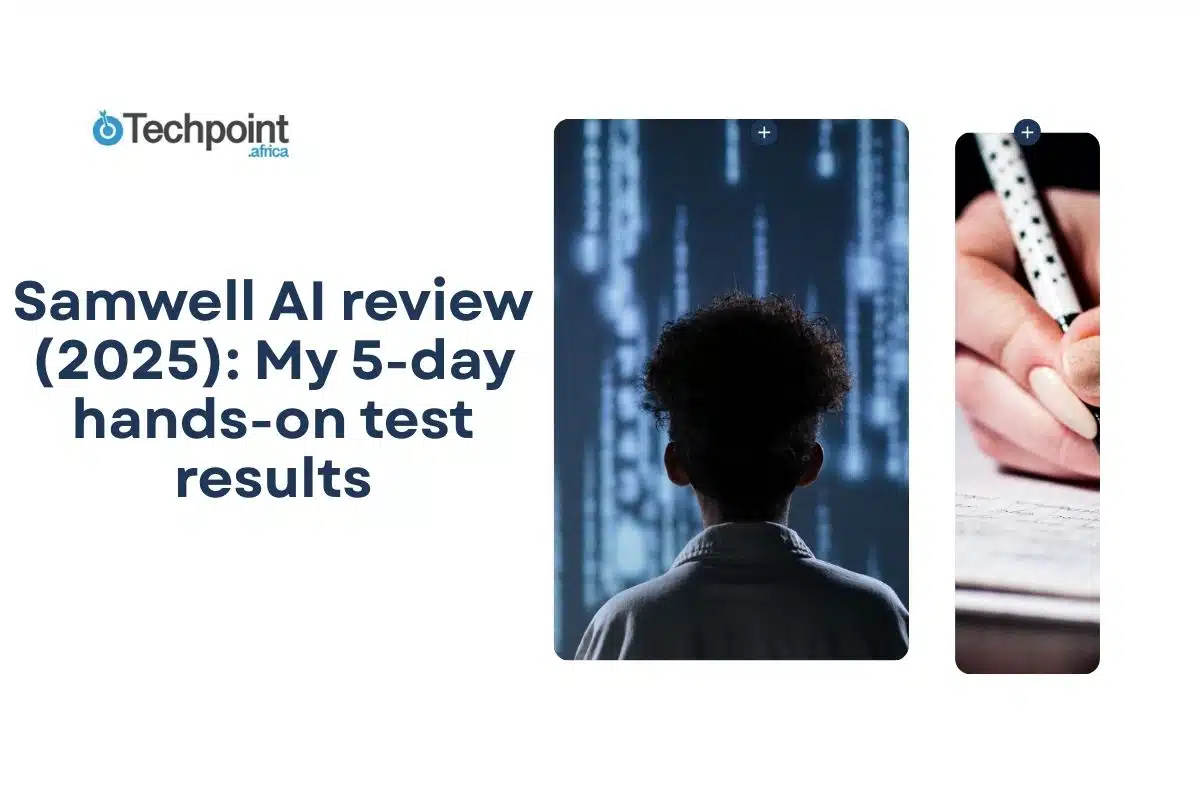There’s always a new AI tool promising to change how we write. Faster essays, smarter outlines, fewer hours staring at the blinking cursor of doom. And I’ve tested enough of them to know the hype rarely survives contact with a real deadline. But when I first stumbled on Samwell AI, something about it made me pause.
Maybe it was the promise of a straightforward, structure-savvy essay assistant that doesn’t just spit out filler paragraphs but helps you think through an argument. Or maybe it was the minimalist design and whispers from YouTube that it’s like ChatGPT but more academic, more focused.
So I gave it five days. Five honest days of essay planning, writing, editing, and research, from scratch. No polished prompts, no hand-holding. Just me, my ideas, and a curious little essay partner named Samwell.
In this review, I’ll walk you through everything I found: what it gets right, where it stumbles, and whether it’s useful for students, researchers, or anyone who wants to write smarter, not just faster.
TL;DR: Key takeaways from this article
- Samwell AI is an academic-first tool. It’s built specifically for students, researchers, and essay writers. It’s not trying to be your next coding buddy or marketing strategist.
- From automated MLA citations to guided essays, audio summaries, and video references, it packs a lot of academic firepower into a simple interface.
- It’s not without flaws. The writing can sometimes feel a little templated, and the “free” version is more like a demo. Also, it needs internet access and doesn’t offer offline use.
- It’s best for short-term, structured writing. Think essays, term papers, or reflection prompts, not novels, thinkpieces, or full research projects.
- If you’re someone who often deals with citation styles and research deadlines, Samwell AI is worth a shot. That said, go in knowing you’ll likely still need to do some editing.
Understanding Samwell AI?
Samwell AI positions itself as an intelligent, context-aware writing assistant built specifically for academic and essay-based tasks. It both thinks and writes for you.
What is Samwell AI?
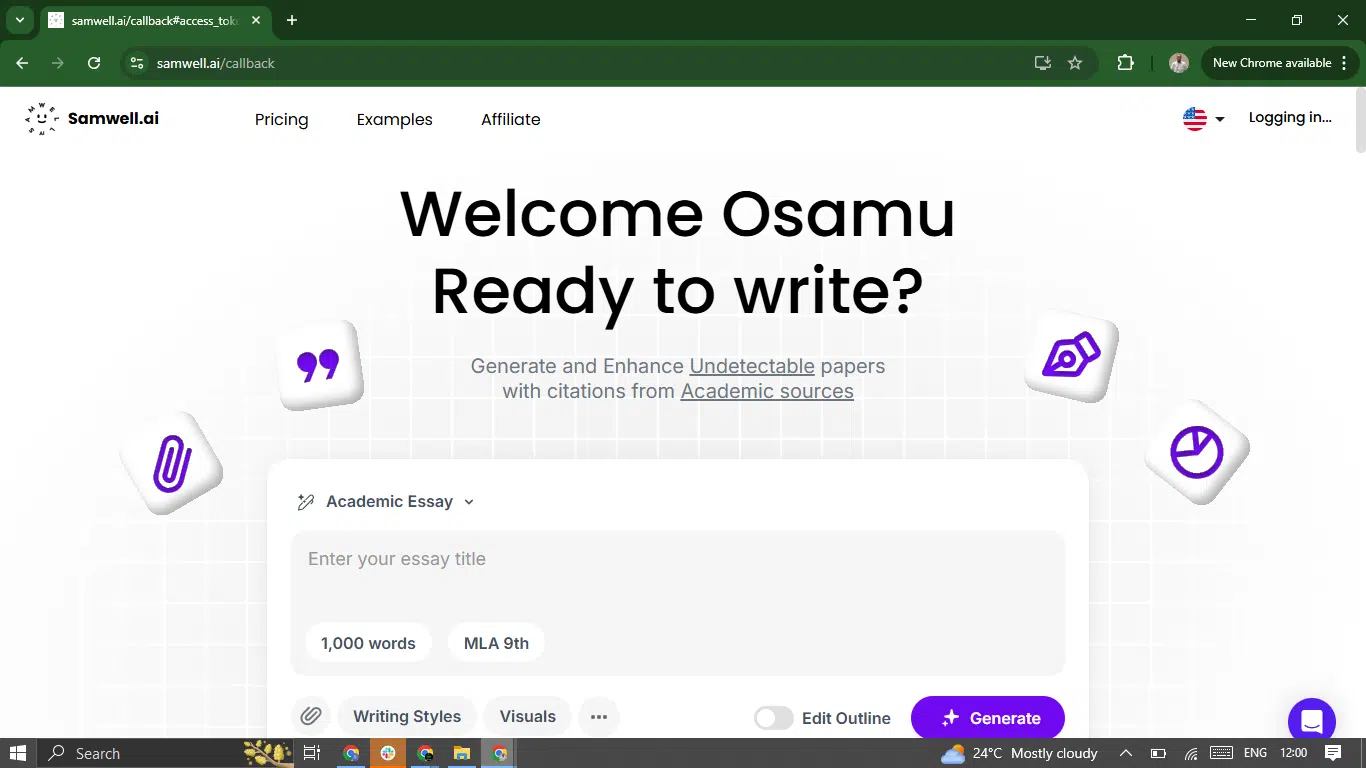
Samwell AI is a focused, essay-first writing assistant designed to help students, researchers, and writers tackle long-form academic-style content. It’s not an all-purpose chatbot or a shiny productivity dashboard. Its modes include academic essay, research paper, literature review, paper enhancement, and AI tutor.
Think of it more like a dedicated study partner who’s unusually good at structure, clarity, and logic, and never gets tired.
At its core, Samwell is built to guide you through the essay-writing process step by step. You can brainstorm topics, refine your thesis, build coherent outlines, and draft structured paragraphs, all within the same flow. It’s less about flashy features and more about helping you think through your argument clearly and effectively.
It doesn’t pretend to write like a human or offer cute motivational quotes. What it does offer is cognitive scaffolding: it asks the right questions, nudges you when you’re vague, and keeps your writing on track.
If ChatGPT feels like a jack-of-all-trades, Samwell is a specialist focused solely on helping you build strong, well-reasoned essays without the cognitive chaos.
How does Samwell AI work?
At a high level, Samwell is built on top of large language models, most likely a state-of-the-art LLM like GPT-4 or similar, but it’s layered with a purpose-built structure for writing. That structure is what makes it feel different from just chatting with a blank-slate AI.
Instead of dumping out answers to prompts, Samwell walks you through the process of essay creation: from clarifying your topic to refining your thesis, building an outline, and even generating paragraph drafts based on your input. Think of it as a 24/7 writing tutor that guides without lecturing, perfect for late-night drafts..
Here’s what stood out to me while using it:
- LLM + structure overlay: Samwell uses a traditional language model under the hood, but with extra layers for task framing and essay logic. It guides your thinking with structured steps instead of open-ended rambling.
- Browser-based: Everything runs in the web app. No extensions, no installations. Just sign in and start outlining.
- Session memory that’s scoped to your essay: Unlike tools that either forget everything or try to remember too much, Samwell tracks your thesis, key arguments, and outline in real-time, flagging tangents with gentle reminders.
- Ideal use cases: Academic essays, opinion pieces, research-based writing, thematic analysis, or even structured personal statements. Basically, anything with a beginning, middle, end, and a point to prove.
I like that it doesn’t try to be everything. It just focuses on helping you actually write the essay, not just brainstorm it and leave you hanging.
Samwell AI at a glance
| Developer | Samwell Labs |
| Year launched | 2024 |
| Type of AI tool | Essay assistant / academic writing companion |
| Purpose | To help users brainstorm, outline, structure, and draft essays |
| Platform availability | Web-based (browser only, no desktop or mobile app yet) |
| Top 3 use cases | Essay writing, research paper structuring, and thesis development |
| Who is it for? | Students, researchers, essayists, grant writers, and lifelong learners |
| Starting price | $12/month |
| Free version? | Yes, limited sessions or capabilities |
Major benefits of Samwell AI
Here’s why people are starting to ditch basic AI chatbots for Samwell, and why it might earn a spot in your writing workflow:
1. Helps you write better, not just faster
Samwell doesn’t rush you to generate a full essay in one click. Instead, it slows things down just enough to help you think, ask the right questions, and build strong arguments step by step. It’s more of a logic partner than a content vending machine.
2. Context-aware session memory that stays focused
Samwell remembers the core components of your essay, including your thesis, outline, sections, and keeps them top of mind as you build. Unlike other AI tools that drift mid-session, Samwell stays anchored to your structure and goals.
3. Guided workflows tailored for essay writing
Whether you’re brainstorming, outlining, or drafting, Samwell guides you with prompts that feel useful, not robotic. It suggests structure, asks clarifying questions, and gently pushes your ideas forward without ever stealing the wheel.
4. Designed for real academic tasks
There’s no fluff here. Samwell is built with students and academic writers in mind. Its outputs are formal when needed, citation-aware (depending on your input), and structured like a real academic argument, not just unnecessary words padded around a keyword.
5. Minimal interface
The interface is clean and calm. No unnecessary tabs, widgets, or distractions. It’s designed for long-form thinkers who need to wrestle with complex ideas without ten buttons blinking at them.
6. Smart prompting that improves your arguments
This was one of my favorite features, Samwell also refines with you. It often rephrases your thesis, highlights inconsistencies in your arguments, or flags where you’re missing support, things that made my essay stronger.
7. Built for solo writers who need structure
If you often find yourself with good ideas but no clear roadmap, Samwell shines. It helps turn brain fog into bullet points, then into well-developed sections, all without making you feel like you’re just clicking through a script.
Why I decided to use Samwell AI
When I was in uni, a tool like this would have come in handy on those days when I was doing a little too much at the same time. Since then, I’ve been on the lookout for writing tools that help you think and write good academic papers, even if it’s just to keep up with how technology in academia is evolving. Most AI writing assistants feel like sugar highs: impressive at first, but shallow once you ask them to build a real argument or follow a coherent thesis.
Samwell caught my eye because it seemed different. It wasn’t promising to do everything. It wasn’t trying to be my productivity coach or task manager. Instead, it was positioned as a focused, thoughtful essay companion that could help me wrestle with messy ideas, develop structure, and write with intention.
My goal for testing Samwell AI
I went into this test with a clear mission:
- To see how well it supports structured essay writing. Can it help me outline, refine a thesis, and build logical sections?
- To evaluate how it handles context. Will it remember what my essay is about over multiple steps, or will it fall off the rails?
- To judge its usefulness as a long-form writing partner. Can I rely on it to build a draft I’d consider turning in or publishing?
- And to test its clarity. Does it simplify the writing process, or add more friction?
Getting started with Samwell AI
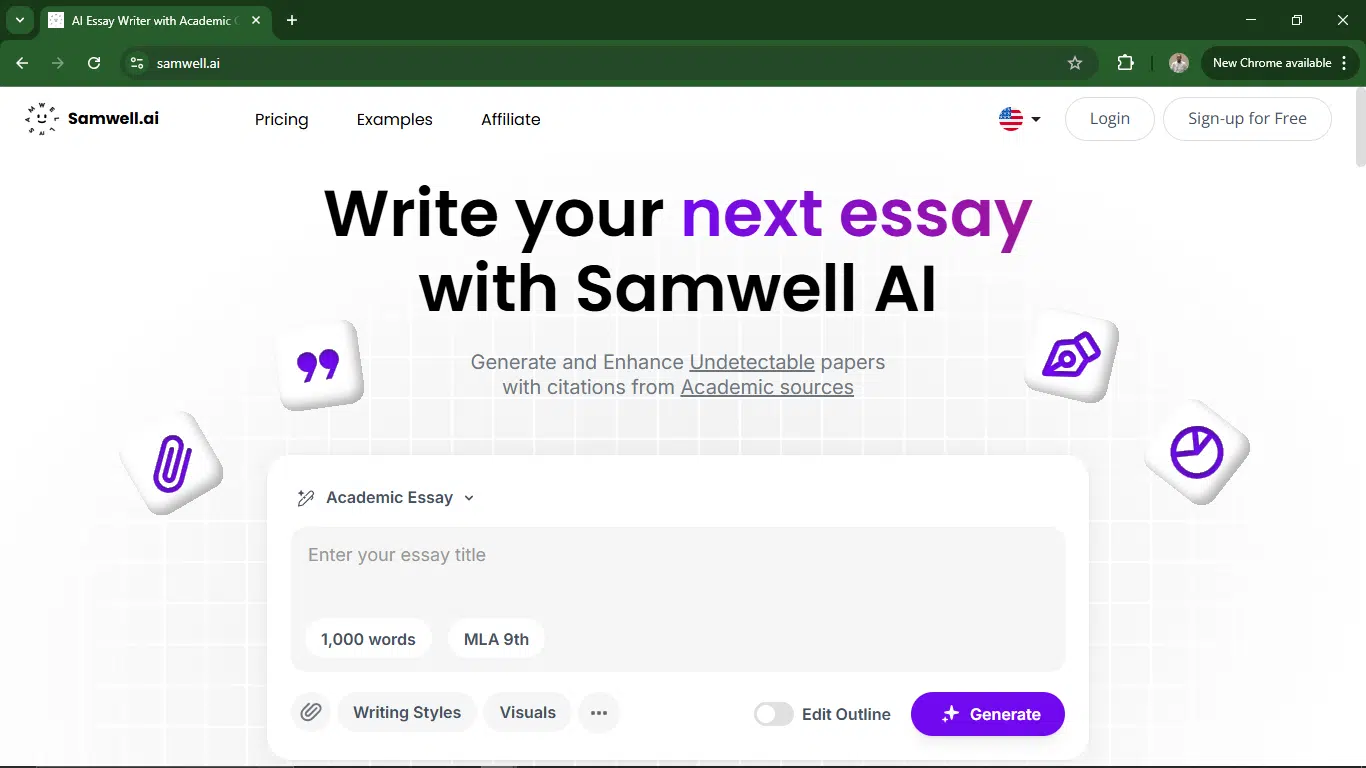
I’d never used Samwell before, so this was a fresh start. It was just me and whatever waited behind the Sign Up For Free button. One click, a name, and an email later, I was in. No awkward onboarding quizzes. No mandatory tutorials pretending to be helpful. Just a calm interface, quietly waiting for me to type something.
My first impression of Jasper AI
The first thing I noticed was the UI. Sleek. Clean. Slightly playful, but not trying too hard. It feels like the team behind Samwell respects your brain. No clutter, no flashing widgets, no “Try this amazing thing now!” pop-ups. The color palette is soft and focused, and the website feels fast and responsive, even on my tab-stuffed browser.
The signup process took less than a minute, and once I was in, there wasn’t a long “let us show you how great we are” tour. It just placed me at a friendly prompt and let me lead. That kind of minimalism might not wow everyone, but to me it said we’re not here to distract you or get in the way of your work. We’re here to help. And I appreciated that.
How easy it is to use Samwell AI
The interface is clean enough that I didn’t need instructions, and that’s a good sign. You type. It responds. There’s a subtle structure guiding you, like session summaries and a gentle chat memory, but no overwhelm.
What stood out is how quietly smart it is. If you ask vague questions, it helps you refine. It gently nudges you toward clarity. That’s not common, even among the “best” AI tools I’ve used.
I didn’t need to read any docs. No Chrome extension. No extra context window. Just a smooth, quiet ramp into my first real conversation with Samwell.
Key features I explored
When I started using Samwell, I expected a writing assistant. What I found was something closer to a research partner that polishes your grammar and helps you think, organize, and present your ideas like a pro.
Here are the features that stood out to me over five days of testing:
1. Instant research paper drafts
This feature got me hooked. Samwell builds out structured academic-style papers on demand. You can feed it a topic or even a vague idea, and it’ll spin up an essay with a clear thesis, arguments, and citations. It’s like having a ghostwriter who always has the MLA stylebook open.
2. Plagiarism-free content
I tested a few paragraphs through Grammarly and QuillBot’s plagiarism checker, and everything came out clean. It’s not recycling Wikipedia dump or scraping Reddit threads. The generation process feels original, and more importantly, sound. Beyond speed, the tool generates content that holds up under scrutiny.
3. In-line citations
Look, I love writing. But I’ve never looked forward to formatting citations at midnight. Samwell auto-generates in-line citations based on actual references it pulls, which means you can focus on the argument, not citation syntax.
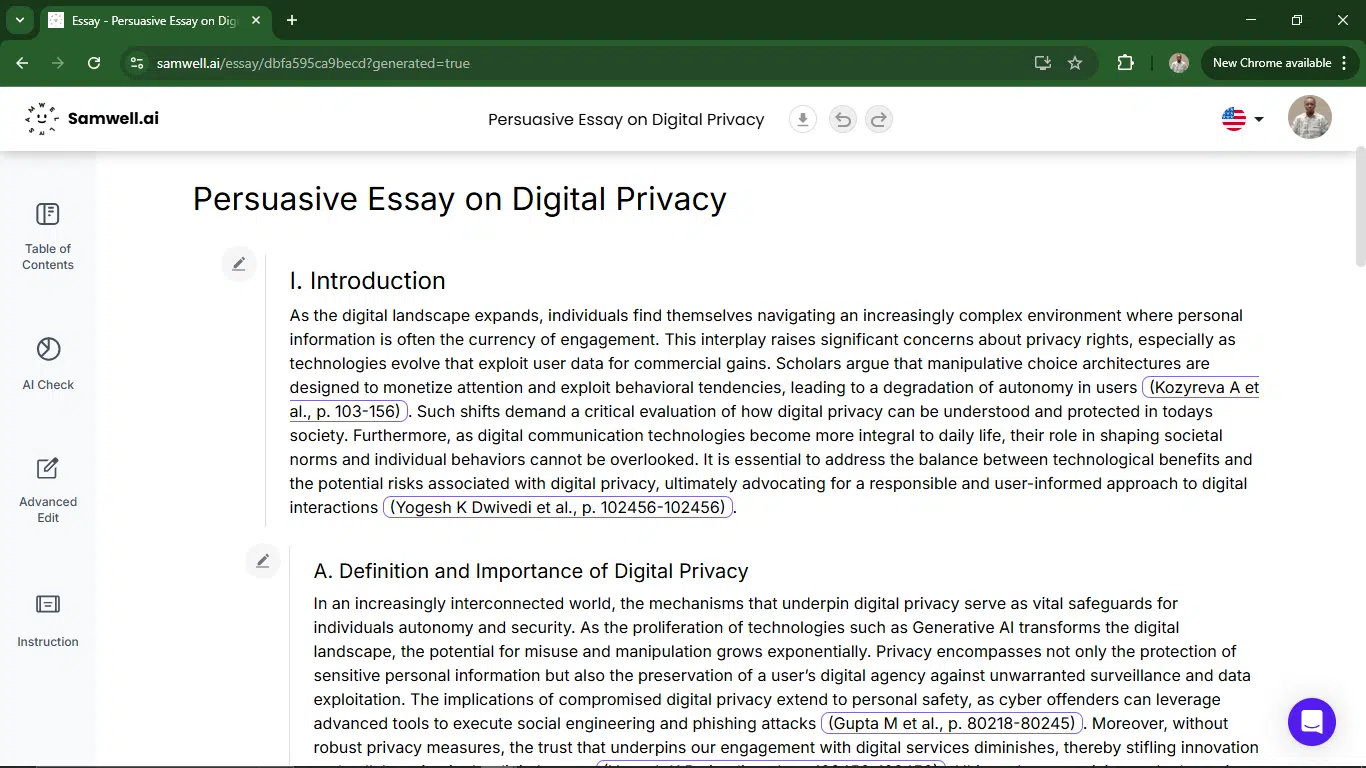
4. Audio summaries
This one surprised me. After writing a full essay, Samwell offered a short audio summary I could play back like a podcast snippet. If you’re someone who thinks better when hearing things, or just want to review while walking, it’s wildly useful.
5. Video references
Samwell doesn’t just rely on academic papers or websites. It also pulls relevant YouTube videos based on your essay topic and cites them as supporting material. It’s not just any video either, most videos were from educational creators, professors, or docu-style explainers. It felt like having a visual bibliography.
6. Guided essay templates
Sometimes the hardest part is knowing where to start. Samwell offers “guided essays,” where it leads you step by step, from intro through thesis, body points, and transitions, all the way to the conclusion. It’s not rigid, but it’s enough structure to help you move without stalling. This was great for starting cold on unfamiliar topics.
7. Interest-based connection
This feature might fly under the radar, but I found it smart. Samwell tries to connect new topics to what you’ve worked on before, like referencing prior discussions or writing sessions. It makes new content feel more familiar, almost like it’s nudging your brain to recognize patterns and retain more.
8. Customised instructions
Another cool detail, you can give Samwell specific instructions about tone, quotes, arguments, or even required sources, and it listens. I told it to include a line from Chinua Achebe in an essay on post-colonial literature, and it found a quote that made sense in context, not just thrown in for keyword density.
9. Writing style adjustments
You can ask it to rewrite or polish a paragraph in different tones: formal, concise, persuasive, etc. The “academic tone” setting in particular produced clean, citation-friendly language without sounding robotic.
10. Revision and feedback assistant
Once I had a full draft, Samwell offered feedback like a writing tutor would. Are your points repetitive? Is your evidence balanced? Where could your conclusion go further? It didn’t only fix grammar, it was concerned about the substance.
My hands-on experience over 5 days
I tested it for 5 days, but I’ll use two tasks to explain how well Samwell AI is.
Task 1: Argumentative essay
I started simple. Signed up, explored the interface, and tested how well Samwell could help me write an argumentative essay from scratch. My goal here was to test how well it handles topics that involve nuanced arguments.
The essay title I gave is: Does immigration benefit the immigrant or the host country?
Samwell AI’s response:
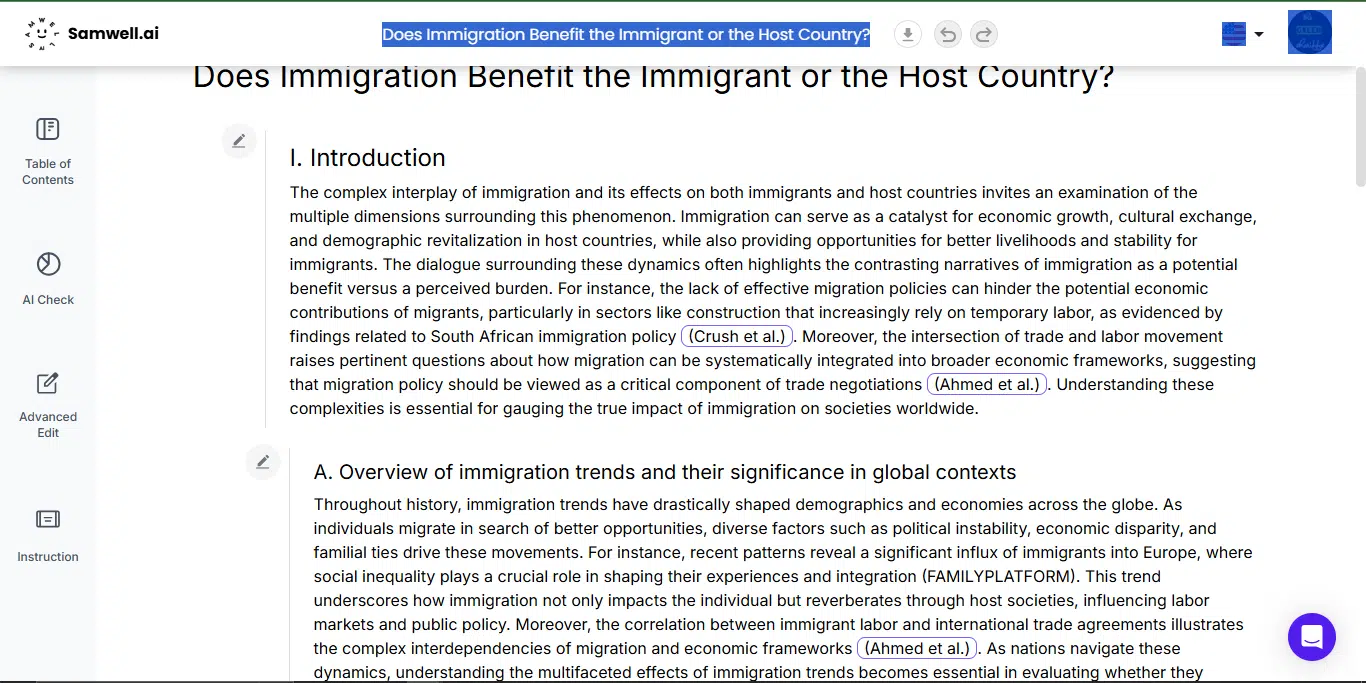
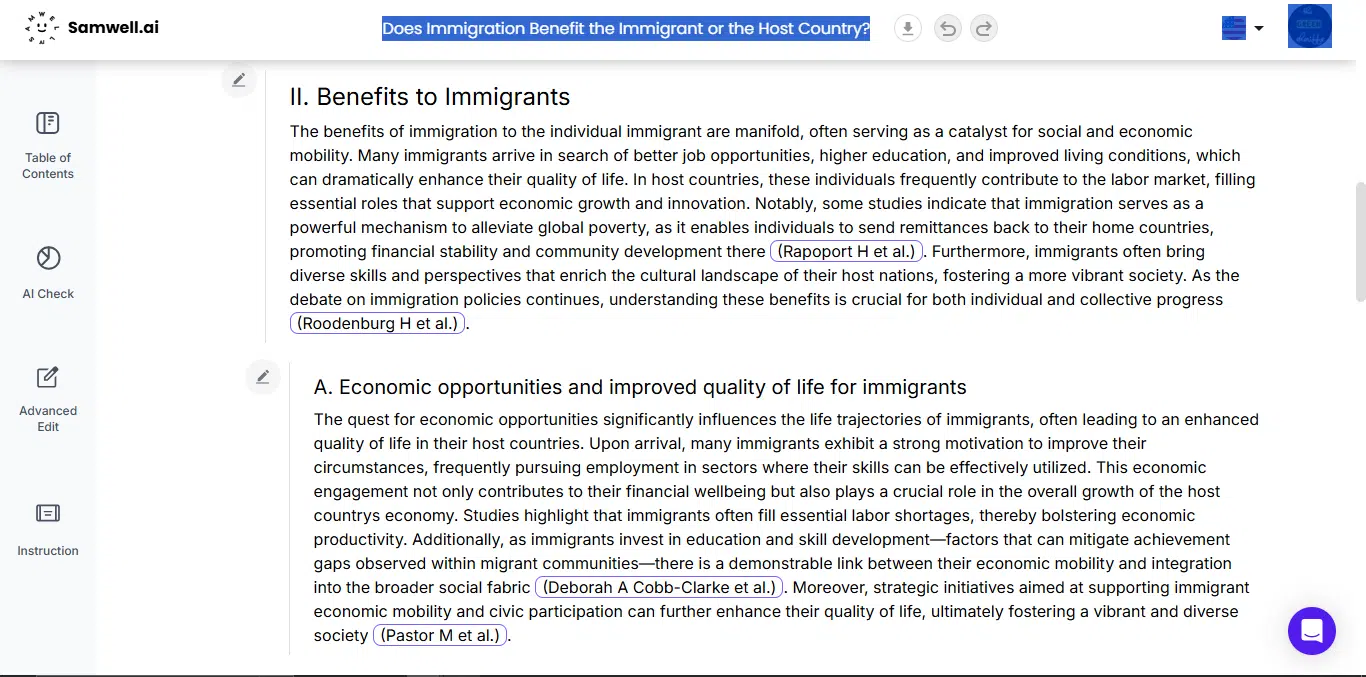
1. Thesis clarity and argument strength:
The thesis is clear. The introduction presents a balanced view of immigration’s dual benefits. The structure followed a logical flow, and each section (immigrant benefits, host country benefits) flows coherently.
However, since it was an argumentative essay, it could have explicitly stated whether the essay argues that one side dominates (e.g., “While both benefit, host countries gain more economically”). That said, it was a minor weakness here is that
2. Depth of analysis
The essay is evidence-rich as it cites studies on labor markets, welfare states, and remittances. In some areas, however, it seems surface-level; some points lack critical interrogation. For example, it says “cultural exchange” but doesn’t explore it deeply.
3. Evidence and source integration
Strong sourcing. It uses academic papers (e.g., Rapoport on remittances, Folmer on welfare states), and employs proper citations, with in-text citations and references formatted correctly.
4. Coherence and flow
There are smooth transitions throughout, and paragraphs link logically. The article is written in a formal and precise tone: No colloquialisms are used, making it discipline-appropriate language.
Task 2: Persuasive essay
I used it to write a persuasive essay on digital privacy. I wanted to see if Samwell understands the bones of a good essay, not just the skin.
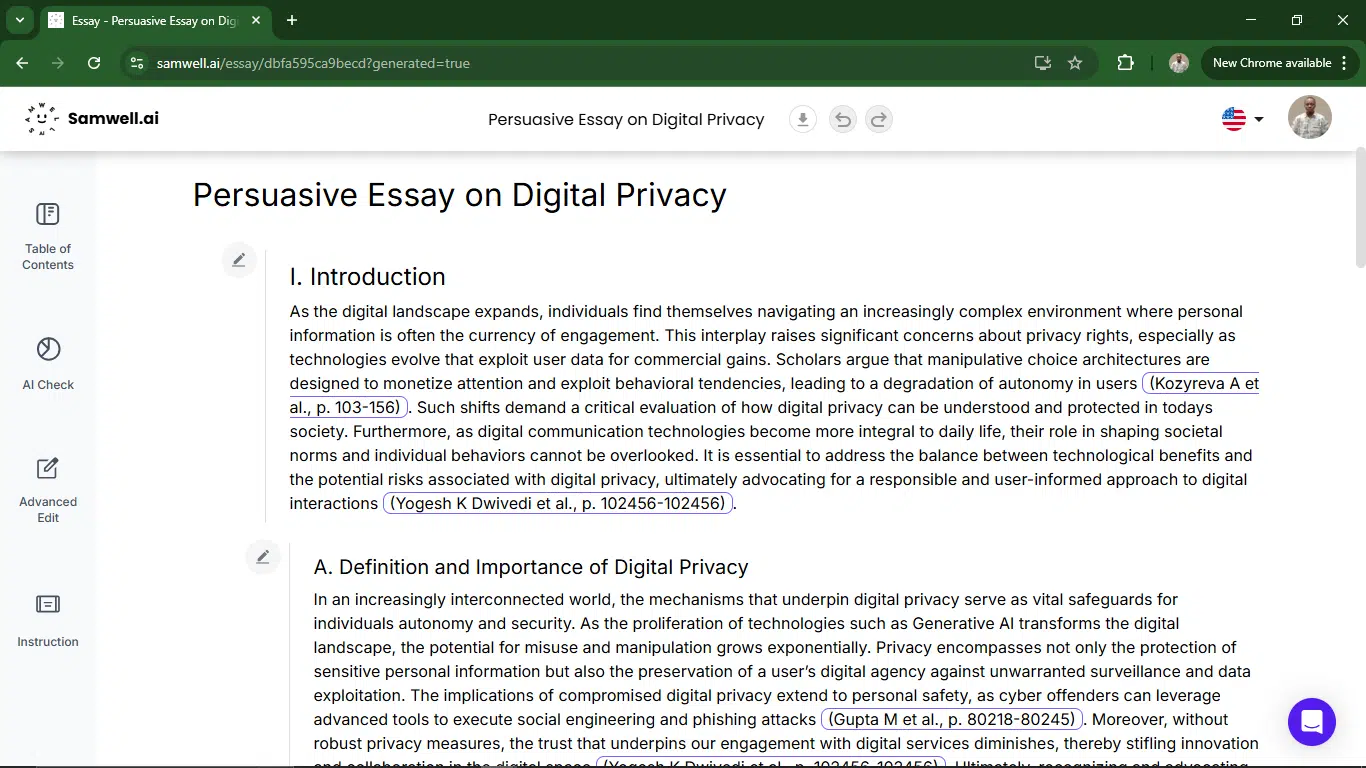
1. Thesis clarity and persuasive focus
Strong thesis. It advocates for digital privacy protections, framing it as a critical issue. It also passed the persuasive intent for me, using urgent language (“compelling an urgent response”) and cites harms (e.g., AI biases, deepfakes).
However, there is a minor gap. It could have explicitly stated the essay’s stance earlier (e.g., “This essay argues that digital privacy must be prioritized over corporate/data-gathering interests”).
2. Depth of analysis
Rich evidence. It draws from diverse sources (AI misuse, GDPR, cybersecurity). Mentioned relevant threats that cover both technical (data breaches) and sociopolitical (democratic erosion) risks.
That said, the counterargument was underdeveloped. It briefly mentions “technological benefits” but doesn’t rebut pro-surveillance arguments (e.g., “convenience” or “national security”).
3. Evidence and source integration
It showed academic rigor, offering ten credible sources, including IEEE, Information Fusion, and peer-reviewed journals. The citation was largely seamless. Several quotes strengthen arguments.
4. Coherence and flow
The essay follows a logical structure: Intro – Body – Conclusion. The conclusion urges “vigilance and responsibility,” aligning with persuasive goals.
5. Comparative quality
Lacks rhetorical punch: Could use more emotive appeals (e.g., anecdotal victims of data breaches).
Applications and use cases for Samwell AI
After five days of testing Samwell, I can confidently say it’s a thinking tool with legs. Whether you’re a student on a deadline or a content creator shaping longform ideas, Samwell has a wide range of real use cases.
Here’s where I see it fitting best:
1. Academic essay writing
This is Samwell’s home turf. From structured research papers to personal reflections, it helps outline, draft, cite, and polish academic writing. If you’re in school, teaching, or working in academic publishing, it’s like a writing TA that never sleeps.
Bonus: You can customize tone, length, and complexity based on your education level, from high school to postgraduate.
2. Research and idea development
If you’re stuck on a thesis or trying to frame a complex idea, Samwell helps you break it down. It asks questions, offers angles, and even pulls in references. It’s not just giving you answers — it’s helping you arrive at better ones.
3. Self-learning
If you want to understand a difficult topic or prep for an exam, you can feed Samwell a subject, and it’ll explain, summarize, or quiz you. Throw in the audio summaries and video citations, and you’ve got an AI tutor on demand.
4. Creative nonfiction and long-form writing
I tested it for more reflective, essay-style content, and it held up. You can ask Samwell to help with outlining personal essays or building arguments around ideas that aren’t purely academic. The structure it provides is surprisingly flexible.
5. Content planning and research briefs
While it’s not a marketing tool per se, Samwell can help you organize research and plan articles or reports. If you’re a writer like me, sometimes the hardest part is shaping your research; this tool helps stitch raw notes into usable outlines.
6. AI-powered brainstorming
Sometimes you just need to talk it out. Samwell excels at Socratic-style prompting. You give it a vague idea, and it pulls it into focus by asking smart questions or suggesting themes. This makes it great for early-stage thinking, even if you’re not writing yet.
7. Language practice and learning support
Although not its primary job, Samwell can help non-native speakers practice written English in a guided and non-judgmental way. It offers corrections, explanations, and simplified phrasing options, all useful if you’re trying to level up your academic English.
What I liked about Samwell AI
After spending five days with Samwell, these were the features and behaviors that quietly stood out:
1. Clear UX that doesn’t overwhelm
This is the first thing that stood out to me when I was using Samwell. The interface is distraction-free, calm, and intuitive. It’s just you, your thoughts, and the AI, no flashy dashboards or hyperactive toolbars. That makes a big difference when you’re trying to focus.
2. It reasons
This isn’t a copy-paste content generator. Samwell thinks with you. I liked how it helped me shape arguments, structure thoughts, and reframe questions. If you’re the type of person who likes to wrestle ideas into shape, Samwell meets you in that mental space.
No doubt, there’s still a large room for improvement here, but so far, it’s impressive.
3. It respects structure
Whether I was outlining an essay or organizing scattered thoughts, Samwell offered gentle structure without boxing me in. It gave me frameworks (thesis > argument > counterpoint > conclusion), but I never felt like I was being pushed down a formulaic path.
3. The built-in citations work
If you’ve ever written an academic paper, you’ll appreciate how big a deal this is. There are tools out there that promise in-line citations but end up hallucinating or just dropping generic links. Samwell’s MLA citations held up for the most part. The sources were real, the placement was logical, and it didn’t overdo it or fake it. I found this to be very useful and cool.
4. Audio and video add-ons feel thoughtful
The audio summaries and YouTube video references are surprisingly helpful. If you don’t have time to re-read a long piece, I could just listen to the gist. And the video recs were often relevant, not random filler. The cool thing about these two features is that they could easily have been feature dumps, but they seem to have been built with intent.
5. It’s fast
Samwell knows deadlines don’t wait. When you need a research paper done quickly, whether it’s last-minute cramming or just a packed schedule, it delivers solid drafts fast. This is about rushed yet efficient, usable output that saves you precious time without sacrificing quality.
6. Authenticity
One thing I tested thoroughly was originality. Samwell doesn’t cut corners by recycling content or scraping generic info. It builds unique, plagiarism-free work that you can stand behind without second-guessing. This peace of mind matters, especially in academic or professional settings where credibility is everything.
7. User-centric customizations
This isn’t a one-size-fits-all tool. Samwell lets you guide how your essays unfold. Want a formal tone, a specific quote, or a particular angle explored? You tell it, and it adapts. This level of control means your final piece feels personal and tailored, not robotic or cookie-cutter.
What I didn’t like about Samwell AI
No tool is perfect, and Samwell AI is no exception. After five days, here are some areas where it didn’t quite hit the mark for me:
1. Occasional over-structuring
Sometimes Samwell’s helpful frameworks felt a bit too rigid. When I wanted to explore more freeform or creative writing, it nudged me back into an academic formula. That’s great for essays, less so for brainstorming or storytelling.
2. Limited formatting options
If you’re used to tweaking fonts, headings, or embedding images directly, Samwell’s editor can feel basic. Export options are solid, but the writing interface itself lacks advanced formatting, which might slow down power users.
3. Sometimes repetitive phrasing
On a few occasions, I noticed Samwell repeating similar sentence structures or phrases within the same essay. It wasn’t a dealbreaker, but it did pull me out of the flow a little. Some may argue that even a human writer is bound to make one or two repetitions.
4. Occasional hallucinations in references
Most of the time, sources were accurate and relevant. However, on rare occasions, Samwell referenced articles or facts that didn’t check out on closer look. So, always double-check your bibliography.
5. No real-time collaboration
If you’re working in a team or want to co-write with others, Samwell doesn’t offer live collaboration features yet. That could be a blocker for some users. If the tool wants to see wider use, this is a feature they might need to consider.
6. Tailored for academia
Samwell AI shines brightest when it comes to academic writing. Its features and guidance are designed with essays, research papers, and formal structures in mind. That focus means if you’re branching out into more creative or informal writing styles, you might feel a bit boxed in at first.
However, with some experimentation and creativity, you can still tweak its capabilities to fit other writing modes. It’s less about limitations and more about learning how to bend the tool to your needs.
7. Online dependency
Since Samwell AI is entirely web-based, you’ll need a reliable internet connection every time you want to use it. No offline mode means no writing on the subway or during sudden Wi-Fi drops.
Planning for your data or connectivity is a must to avoid interruptions. It’s a small price to pay for the cloud-powered smarts, but it’s worth knowing upfront if you tend to work in low-connectivity spots.
Samwell AI pricing
| Plan | Price | Features |
| Free | $0 | 1,000 AI-generated words Citations 100% authentic sources Build one AI tutor study course |
| Academic | $12 per month | 200,000 AI-generated wordsVerified academic sources and in-text citationsIncludes charts, quotes, and relevant imagesUnlimited AI edits and rewritingCritical thinking mode Bypass AI detectors Unlimited AI tutor courses |
Who should use Samwell AI?
Samwell AI isn’t for everyone, and that’s okay. After testing it thoroughly, here’s who I think will get the most out of it:
- Students and academics: If you’re grinding through research papers, essays, or thesis drafts, Samwell can be useful. Its citation tools, structure guidance, and research capabilities make it a serious time-saver without cutting corners.
- Writers who crave structure: Whether you’re crafting a longform article or a detailed report, and you appreciate frameworks to shape your ideas, Samwell will feel like a helpful partner rather than a creative dictator.
- Lifelong learners and self-studiers: If you like learning by writing, summarizing, or explaining concepts aloud, Samwell’s audio and video features can boost your comprehension and retention. It’s like having a tutor who adapts to your pace.
- Non-native English speakers: if you need help polishing academic English or want to practice formal writing, Samwell’s guided tone and phrasing support make it easier to write confidently and correctly.
- Researchers and content planners: For anyone needing to organize notes, brainstorm ideas, or quickly generate research briefs, Samwell offers a neat blend of automation and thoughtful guidance.
Who might not vibe with Samwell AI?
- Folks who want freeform, casual writing without any structure.
- People who are looking for quick SEO content or marketing copy generators.
- Users who need offline access or real-time collaboration features.
How to make the most of Samwell AI
Samwell AI has range, but only if you know how to work with it.
Here’s what I learned after five focused days:
1. Use guided essays to structure your thinking
When you’re stuck on how to begin, lean on the “Guided Essay” feature. It offers a framework (thesis, arguments, conclusion) that you can customize. It gives you a solid launch pad.
2. Give feedback often
Use the in-app options to tweak responses. Samwell learns from this. Over time, it gets better at mirroring your tone, structure preferences, and reasoning style.
3. Don’t skip the setup
Take a few minutes to fill out your preferences, including:
- Writing style.
- Word count.
- Citation format and frequency.
- Language.
- Reference publish year (how recent do you want your citations to be?).
- Type of essay
Take the instruction option to clarify exactly what you want and how you want it.
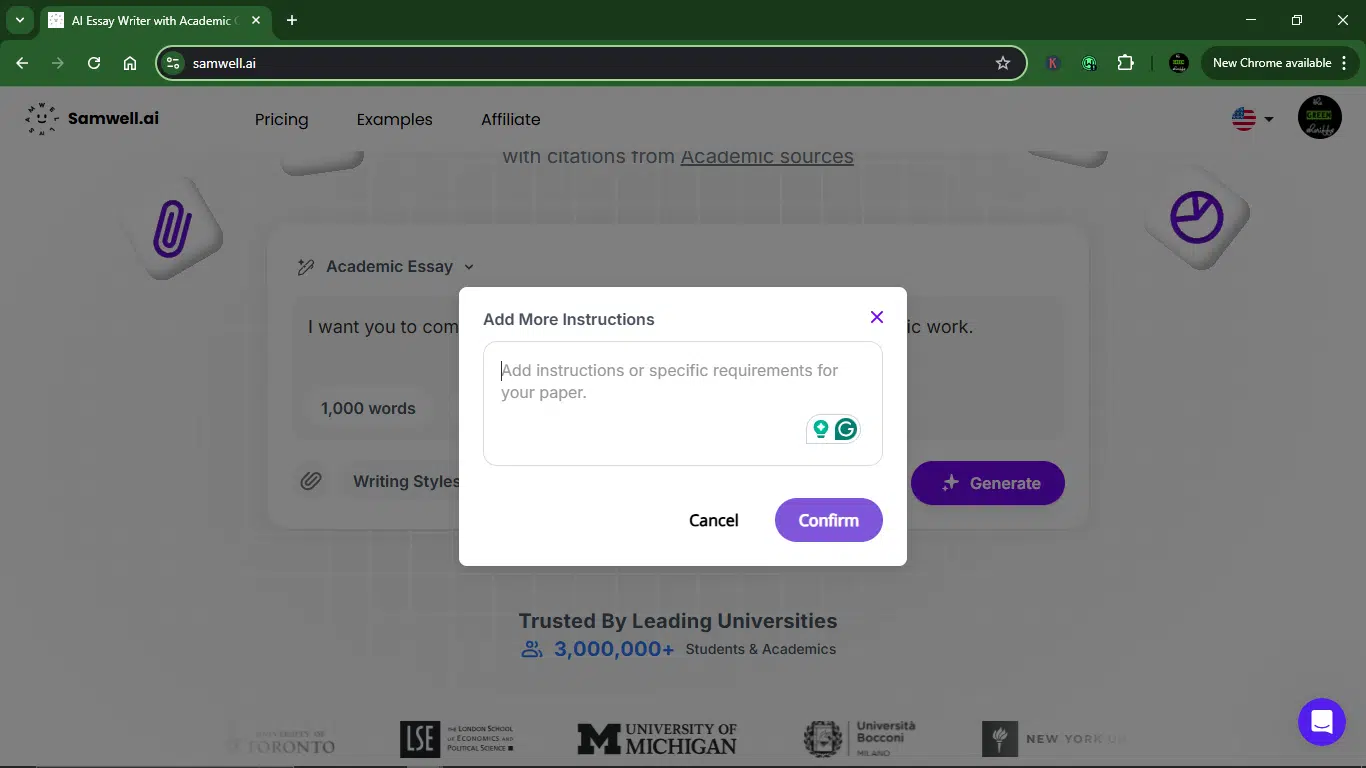
4. Use audio summaries to review faster
After writing something long or dense, switch to audio mode and listen back. It’s a great way to catch awkward phrasing or spot areas that need tightening, especially when your eyes are tired.
5. Leverage the video references
If you’re a visual learner (or just want to enrich your paper), check out the YouTube recommendations Samwell provides. They’re usually relevant and can spark new ideas or angles to explore.
6. Pair Samwell with human feedback
Before hitting submit or publish, run your draft by a friend, mentor, or editor. Samwell gets you mostly there, and the final touch still benefits from a human perspective. This isn’t even to knock down Samwell; it’s just good practice.
7. Still verify the plagiarism
Yes, it’s original. But always double-check key facts, sources, and citations. AI is smart, but it still hallucinates sometimes. Trust, but verify.
8. Save as you go
If you’re using the free version or working on a long draft, make it a habit to copy your text out or hit export regularly. You don’t want to lose work due to browser issues or session timeouts.
How Samwell AI compares to competitors
I’ve tested quite a few AI writing tools, from Jasper AI to Claude and ChatGPT, and Samwell AI lands in a unique spot. It’s not trying to be everything to everyone. Instead, it’s laser-focused on academic writing, and that focus comes with both advantages and trade-offs.
Samwell AI vs. ChatGPT
ChatGPT is a general-purpose AI. It can write stories, answer questions, debug code, or help with emails. But when it comes to academic writing, Samwell feels more specialized. It comes with built-in citation formatting (MLA, for now), essay structuring tools, and features like audio summaries and video references that you won’t get out of the box with ChatGPT. That said, ChatGPT wins on flexibility and creative range.
Samwell AI vs. Jasper AI
Jasper is marketing-forward. It’s brilliant for ad copy, blog posts, SEO content, and brand messaging, but not ideal for serious research or formal essays. Samwell flips that. It’s academic-first, with no distractions from commercial templates or sales tones. If your writing lives in libraries instead of landing pages, Samwell’s the better fit.
Samwell AI vs. Scite.ai
Scite is more of a research companion than a writing assistant. It helps you find peer-reviewed papers and citation evidence, but doesn’t write essays for you. Samwell, on the other hand, handles the full workflow, from structuring your paper to suggesting quotes, building arguments, and citing sources. Think of Samwell as the writing layer built on top of tools like Scite.
Samwell AI vs. Grammarly or Quillbot
These are editing tools, not full writing engines. Grammarly helps polish your tone and grammar, and Quillbot rephrases what you’ve already written. Samwell creates the first draft, with structure, citations, and even creative input, then you can plug in Grammarly or Quillbot later to clean it up.
In summary, Samwell is trying to be the most helpful one for students, researchers, and academic writers. And in that lane, it holds its own impressively well.
Conclusion: Is Samwell AI worth it?
After five days of using Samwell AI, I think if you’re a student, researcher, or academic writer, this tool is one of the best companions you can have in 2025. It’s not trying to dazzle with buzzwords or pretend to be your all-in-one AI overlord. It knows its lane is academic writing and stays in it confidently.
The features are both flashy and functional. From auto-citations and guided essays to audio summaries and tailored feedback, Samwell feels thoughtfully built for people who live in lecture halls and library tabs. It still has its rough edges, like limited creative range and online-only access, but none of them were dealbreakers for how it’s meant to be used.
Would I use it for writing marketing copy or brainstorming product names? Probably not. But if I had a last-minute term paper, research summary, or thought piece to crank out in under an hour, I’d log into Samwell without hesitation.
That said, it bears mentioning here that the whole point of academics is to build analytic rigor and clear thinking. Tools like Samwell AI should only ever be used as an aid, not the main thing.
FAQs about Samwell AI
Is Samwell AI trustworthy?
Mostly, yes, but with caveats. Samwell delivers what it promises on paper: AI-generated academic content, citations, and structured essays. But the writing often feels generic, and you’ll likely need to revise it heavily to make it your own. It doesn’t raise red flags around data privacy or sketchy behavior, but if you’re expecting a best-in-class AI writer, it’s not quite there yet.
Is Samwell AI free?
Not really. It offers a free plan, but you’re capped at just 1,000 AI-generated words, which barely covers a short essay. Think of it more like a demo than a usable version. If you’re hoping to write a full research paper or test out its depth, you’ll run into a paywall pretty quickly.
How do you use Samwell AI?
It works a lot like other AI writing tools. Once you sign up, head into the dashboard, choose your essay topic, set instructions, select your citation style (MLA, etc.), and hit generate. From there, you can tweak, expand, or refine using built-in editing tools, including citation helpers and tone adjustment options.
How do I cancel Samwell AI?
Go to your account settings, hit “Billing,” then “Cancel my subscription.” Simple in theory, but some users online say the process can be glitchy or delayed. Samwell isn’t known for flexible refund policies, so if you’re on the fence, set a reminder to cancel before your billing cycle renews.
Can I use Samwell AI for professional writing?
Yes, kind of. While it’s built for academia, you can repurpose its structure and citation tools for things like reports, research-backed blog posts, or newsletters. That said, you might still need to adjust the tone and formatting to better fit non-academic writing.
Does Samwell AI retain memory of past essays?
Not really. Unlike long-term AI companions or research assistants, Samwell doesn’t hold onto your previous sessions or learn from past inputs. Each project is treated as a fresh start, which can be good for privacy, but bad if you’re trying to build a cohesive multi-part paper or thesis.
Does it require internet access to work?
Yes. Samwell AI runs entirely in the browser, so there’s no offline mode. If your Wi-Fi goes down mid-session, you’ll have to wait it out or copy-paste your progress elsewhere. It’s very much a cloud tool, not a downloadable desktop app.
Does Samwell AI cite real academic sources?
It does a decent job pulling in relevant citations, but it’s always worth double-checking the sources. Sometimes you’ll get placeholders or references that sound scholarly but don’t exist (the classic “AI hallucination” problem). Treat Samwell’s sources as a starting point, not gospel.
Disclaimer!
This publication, review, or article (“Content”) is based on our independent evaluation and is subjective, reflecting our opinions, which may differ from others’ perspectives or experiences. We do not guarantee the accuracy or completeness of the Content and disclaim responsibility for any errors or omissions it may contain.
The information provided is not investment advice and should not be treated as such, as products or services may change after publication. By engaging with our Content, you acknowledge its subjective nature and agree not to hold us liable for any losses or damages arising from your reliance on the information provided.
Always conduct your research and consult professionals where necessary.

